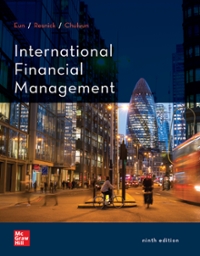Please help with these 3 pictures thank you:)

Stocks A and B have the following probability distributions of expected future returns: Probability 0.1 0.2 0.4 0.2 0.1 (12%) 3 10 19 28 (29%) 0 18 27 47 a. Calculate the expected rate of return, Pn, for Stock B ("A = 10.00%.) Do not round Intermediate calculations. Round your answer to two decimal places. % b. Calculate the standard deviation of expected returns, on for Stock A (0, -19.31%.) Do not round intermediate calculations. Round your answer to two decimal places. Now calculate the coefficient of variation for Stock B. Do not round intermediate calculations. Round your answer to two decimal places. Is it possible that most investors might regard Stock B as being less risky than Stock A? 1. If Stock B is more highly correlated with the market than A, then it might have the same beta as Stock A, and hence be just as risky in a portfolio sense. 11. If Stock B is less highly correlated with the market than A, then it might have a lower beta than Stock A, and hence be less risky in a portfolio sense. III. If Stock B is less highly correlated with the market than A, then it might have a higher beta than Stock A, and hence be more risky in a portfolio sense. IV. If Stock B is more highly correlated with the market than A, then it might have a higher beta than Stock A, and hence be less risky in a portfolio sense. V. If Stock B is more highly correlated with the market than A, then it might have a lower beta than Stock A, and hence be less risky in a portfolio sense. Select C. Assume the risk-free rate is 1.5%. What are the Sharpe ratios for Stocks A and B? Do not round intermediate calculations. Round your answers to four decimal places. Stock A: Stock B Suppose TR 5%, 13%, and b- 1.2. a. What is the required rate of return on Stock i? Round your answer to one decimal place. % b. 1. Now suppose to increases to 6%. The slope of the SML remains constant. How would this affect and n? 1. will remain the same and will increase by 1 percentage point 11. Te will increase by 1 percentage point and will remain the same III. Both and will decrease by 1 percentage point. IV. Both and will remain the same. V. Both and will increase by 1 percentage point. -Select- 2. Now suppose to decreases to 4%. The slope of the SML remains constant. How would his affect and n? 1. will decrease by 1 percentage point and will remain the same. 11. Will remain the same and will decrease by 1 percentage point. III. Both and will increase by 1 percentage point. IV. Both and will remain the same. V. Both and will decrease by 1 percentage point. Select c. 1. Now assume that remains at 5%, but the increases to 14%. The slope of the SML does not remain constant. How would these changes affect n? Round your answer to one decimal place. The new will be 2. Now assume that remains at 5%, but falls to 12%. The slope of the SML does not remain constant. How would these changes affect ? Round your answer to one decimal place. The new n will be We Consider the following information for stocks A, B, and C. The returns on the three stocks are positively correlated, but they are not perfectly correlated. (That is, each of the correlation coefficients is between and 1.) Stock Expected Return Standard Deviation Beta 7.65% 14% 0.7 10.35 1.3 11.25 14 1.5 Fund P has one-third of its funds invested in each of the three stocks. The risk-free rate is 4.5%, and the market is in equilibrium. (That is required returns equal expected returns.) a. What is the market risk premium-)? Round your answer to one decimal place. b. What is the beta of Fund P? Do not round intermediate calculations. Round your answer to two decimal places. c. What is the required return of Fund P? Do not round intermediate calculations. Round your answer to two decimal places. d. What would you expect the standard deviation of Fund P to be? 1. Less than 14% 11. Greater than 14% III. Equal to 14%










